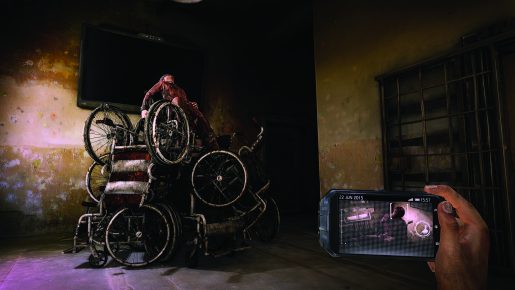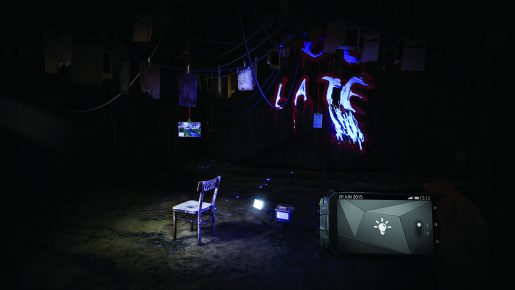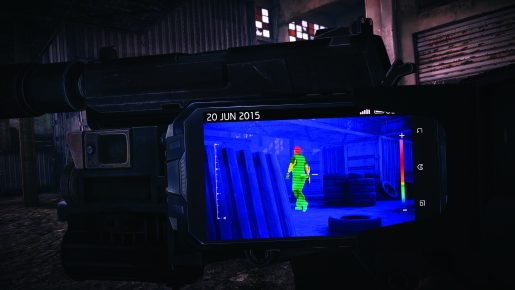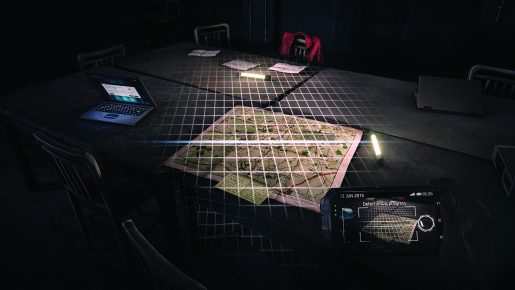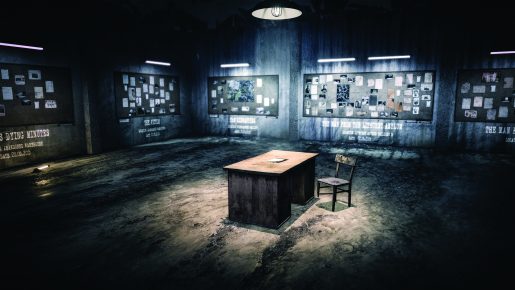Get Even is a brand new first person perspective thriller from Polish developers The Farm 51 and publisher Bandai Namco Entertainment. While the concepts behind the game originated in a prototype as far back as 2010, due to the effects of the worldwide finical crisis it has only been properly in development for the past 3 years. In that time the Get Even has shifted its setting from Eastern Europe to the UK and grown into a grand experience for any gamer.
The first ‘mission’ is as far as I would like to go explaining the story. It is such a central pillar of the game that spoilers, past the prologue, while not ruining the overall experience would somewhat tarnish it. This is because the game revolves around finding out what happened in and around the opening scene. Investigating the investigation and almost diving deeper in the main character’s mind to unravel the mystery.
The first level see’s the main character, Cole Black, navigate his way through an abandoned, dishevelled building. Despite not knowing why Mr Black was there, the player intuitively knows that perhaps he isn’t exactly a welcome guest. Something which only becomes more apparent as you venture through the level. Towards the end of the prologue Mr Black stumbles across a girl, tied to a chair with a ticking clock at her feet. This is where the questions and confusion start for both the character and the player.
The potential hours of questioning and thoughts of “what’s happening?”, confusion and misunderstanding is all worth it for the minutes of clarity at the game’s conclusion. Up to that point of clarity, the player will be wrapped up in a mystery that seems to twist as it develops. The nature of the mystery helps grow the player’s relationship with Mr Black, whom is also questioning what is going on, where is he and what he is there for. Even when some questions are answered more appear allowing intrigue to take over and players will find it hard not to want to know what happened.
The Farm 51 has done something rather special when it comes to the level design. Despite not being an open world game, with a pretty linear path, the visuals of the game make the player feel as they are in a real world. Potentially not an overly living, breathing world with the abandoned nature of some of the game but a real world. While there are few areas with some expanse the tight twisting rooms and long corridors players will explore make it feel like you diving deeper into the world, despite not traversing much distance at all.
Some elements of Get Even are set outside of this world, in a memory flashback style area. This is designed in a distinctive way that sets it apart from the realistic designs completely, preserving the game world’s believability. The game gets away with it thanks to the Pandora headset that Mr Black is forced to wear. This is effectively a VR headset that allows the game to have an excuse for any unusual things occurring in the world. Enough of talk of the Pandora though, you’ll find out more about this device when you play!
Coming from the United Kingdom it is great to see a game that is set in England and one that has so many little details done correctly. It’s almost so unusual to see I was surprised with the accents, the driver’s side of a car being the right and even the details of plug sockets being spot on. What makes this more remarkable is that The Farm 51’s original prototype for the game was set in Eastern Europe with the team having to change everything over when they decided to utilise English, as it was accessible for more players. The buildings and theming have jumped across extremely well from generic Eastern Europe to just south of Nuneaton, in the United Kingdom.
The story is clearly what you play for and what builds the intriguing nature of Get Even that drags you back to the game until the end. The level design that keeps you impressed in this visually stunning world. The sound design however is the third solid pillar that Get Even is built on and it is interwoven with the other two core pillars of the game strengthen them, adding emotion and at times driving your heart rate sky high. At other times the lulls in the music stop you dead in your tracks and I found myself, when this occurred, almost tiptoeing around in anticipation. It is the phenomenal attention to detail and the concept of the sound design that sets Get Even well above most modern triple-A games.
The game world’s sounds and music evolves naturally as the player advances throughout levels. When the story demands emotion the music builds up to support. In a dark corridor, that the designers what you to move through quickly, the tension that builds is even reminiscent of a horror game. The music in Get Even is added in two unique ways to strengthen the atmosphere the player experiences. Some sounds originate solely from the game world itself via the use of radios and other items which usually make noise. This means when wearing a decent gaming headset, if you’re stood in the centre of a room with these sounds originating around you it feels like a believable living world.
The instrumental music that drives much of the tension and emotion often isn’t emitted from normal sound emitting objects yet it isn’t simply laid over the top of the game sounds. Despite not being pitch perfect myself, composer Olivier Derivière revealed that the hum of the light bulbs and the overall room sounds are set to perfect pitches. He has used these small hums and buzzes from the game world to almost organically grow the orchestral music making it naturally added into the game, rather than just added as a layer over the top. It works to engross players into the world and the story at the perfect times.
Get Even has a compelling mixture of genres, not confining itself to one label. The tension takes the game to the edge of being a horror game without the jumpiness. The narrative element with the stunning visuals reminds me of the top walking simulators, yet you interact with the world. The puzzles have minor consequences in the world. Nothing game changing but little differences that may either open opportunities for later or close them off. Going further from a horror game, Mr Black isn’t exactly helpless; being armed and with an incredibly helpful smartphone.
Being armed does turn the Get Even experience into a first-person shooter but does add in the interesting concept of the corner gun. This weapon can be used to swiftly dispatch enemies from around corners in cover. Conversely, it can be used to not kill people. Utilizing the corner gun’s camera players can judge enemy’s walking routes or locations to sneak past undetected. Get Even leaves the choice up to the player. Perhaps because of the similarities to a first-person shooter, in terms of movement, I found the controls intuitive. This leaves you to fall more into the game world and story, undistracted by cumbersome controls.
Players will find themselves navigating the world and wandering around with a smartphone in hand. The phone comes with some rather helpful apps that introduce UI and mechanics that could otherwise have be illusion breaking. Players can use the UV light and infrared to see where things are or where. There’s a map app that the player can simply switch to, to help them navigate around the levels. The player can receive texts and calls which are wrapped into the advancement of the storyline. Finally, players will use the camera to take pictures of evidence, with a signal-like light indicating when the player is close to something of interest. What is intriguing about this is the psychology behind the camera application. I don’t know what it says about myself but despite having the environment in front of me I occasionally found myself viewing the scene in front via the smartphone screen at the bottom right of the screen.
The game is built on the storyline and hinges on the sense of unknown information to drive the player to continue. This means there isn’t a huge draw to replay the game once you have found out what is actually going on. On the other hand, when going back to the beginning it is interesting seeing the hints that you completely miss or simply dismiss at the time. I feel that Get Even is the sort of game you’ll either play again straight away to see the small changes from the minor consequential choices and hints you missed or it’ll be a game you won’t touch again for a while.
Passion for something unique and different has clearly driven the creative processes for Get Even and what an incredible experience has come out the other end. That is what Get Even is, not just a game, it’s an experience. It drives the story forward emotionally, sometimes testing the player with the tension that’s built up and the sense of the unknown that you must discover. Players will feel they need to know what has happened and what a great story there is to investigate and unravel. You might not play it twice but the experience you get from one playthrough is well worth it.
[Editor’s Note: Get Even was reviewed on Windows PC. The game was provided to us for review purposes.]

